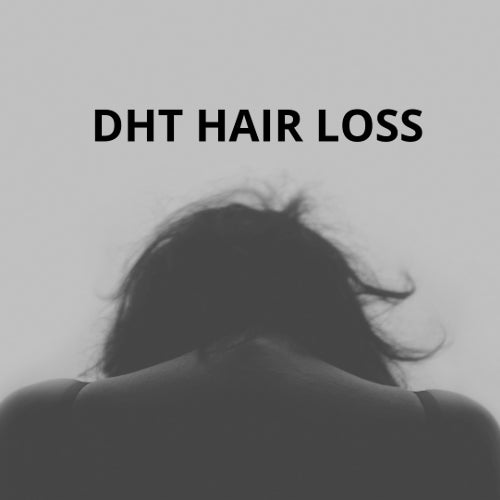The most common type of hair loss is DHT hair loss, also known as Androgenic Alopecia. The odds of having DHT are slim at a younger age but the risk does increase as you age. Read more to find out what DHT is and how it causes hair loss?
What is DHT?
Dihydrotestosterone (DHT) is an androgen hormone, a type of male sex hormone found in both men and women. Androgens are responsible for biological male characteristics like body hair, increased muscle mass, and a deeper voice.
It’s thought that DHT attaches to androgen receptors on the hair follicles. The DHT then causes hair follicles to shrink. As a result, the anagen, or growing, phase of the hair growth cycle decreases in length while the telogen, or resting, phase of the hair cycle is extended.
The anagen phase becomes shorter over time, until eventually no hair grow past the scalp line. Additionally, the hair shaft becomes thinner as the hair follicle shrinks, so hair begins to thin and is more prone to breakage.
DHT and Men’s Hair Loss
Androgenic alopecia is the most common type of hair loss in men. By the age of 50, over half of men will have some type of DHT-related hair loss.
Male pattern baldness presents itself as thinning along the hairline, temples, and crown. Eventually the hair loss spreads, resulting in a horseshoe-shaped ring of hair around the bottom of the scalp.
DHT and Hair Loss in Females
DHT has also been linked to hair loss in women. Though in lower quantities, women typically also have male hormones like DHT in their bodies. An imbalance of hormones or an increased sensitivity to DHT can result in hair loss.
For women, DHT hair loss results in overall thinning rather than the receding hairline and horseshoe pattern seen in men. Women with DHT hair loss usually see the same symptoms as women with other types of hair loss, such as a widening part or smaller, thinner ponytail.
Why Do Some People Have DHT Hair Loss?
For the most part, DHT hair loss is related to genetics. But for people without a genetic cause, researchers have postulated a few characteristics that may cause it in some individuals:
- More androgen receptors on the hair follicles
- Increased levels of DHT in the body
- Higher sensitivity to androgens
- If your hair loss is genetic, you may need a DHT blocker in order to prevent it.
What is a DHT Blocker?
Some medications have the ability to lower levels of DHT, helping to slow or even reverse DHT hair loss.
Finasteride is a DHT blocker that diminishes the enzyme that converts testosterone to DHT, effectively lowering levels of DHT in the body. However, since DHT is so important to reproductive operations of the body, Finasteride can have serious side effects like loss of libido.
Tips for DHT Hair Loss
A dermatologist can help you confirm if your hair loss is DHT-related. Your doctor will be able to diagnose the cause of your hair loss and help you to devise a treatment plan.
With 14 International Medical Device Licenses and 7 FDA Clearances since 2007, HairMax® is the first home-use Laser Photo Therapy device that has been reviewed by the FDA and cleared for the treatment of Androgenetic Alopecia (pattern hair loss), caused by hormonal or hereditary factors in both males and females.




Share:
How Miniaturisation Relates To Hair Loss & Thinning
Why does my hair get greasy?